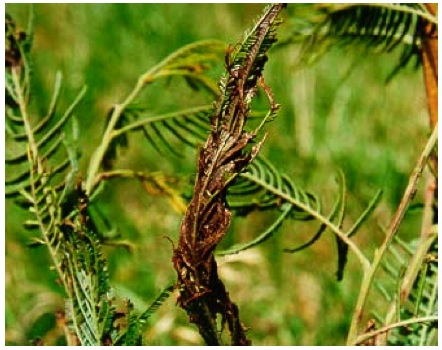PESTS AND DISEASES OF FORESTRY IN NEW ZEALAND
Acacia rust: Uromycladium alpinum
Scion is the leading provider of forest-related knowledge in New Zealand
Formerly known as the Forest Research Institute, Scion has been a leader in research relating to forest health for over 50 years. The Rotorua-based Crown Research Institute continues to provide science that will protect all forests from damage caused by insect pests, pathogens and weeds. The information presented below arises from these research activities.
From Forest Health News No. 90, October 1999.
 Of the 7 species of Uromycladium that infect Acacia species 6 were known to occur in New Zealand prior to 1999. Uromycladium acaciae was described in New Zealand in 1890 and another three species ( U. notabile, U. robinsonii and U. tepperianum ) have been in New Zealand since early this century. Uromycladium maritimum was reported here in 1970 and U. simplex in 1978. Conspicuous twig, branch and stem galls are formed by U. notabile and U. tepperianum on their respective host plants, whereas the other four rusts form leaf and shoot pustules which are more readily overlooked. The seventh species, U. alpinum, was identified on A. dealbata at Gisborne in December 1998 during a routine port environs survey (Colin Barr, Forest Health Adviser). It has since been found in Auckland, Wanganui and Northland infecting A. mearnsii as well as A. dealbata. The disease is characterised on these hosts by vast masses of spores produced in a mucus which coats the pinnae, often webbing the pinnules together. Pinnules are subsequently cast. Newly developing spring flush of infected A. mearnsii becomes distorted and chlorotic. Current indications are that A. dealbata is less susceptible to the disease than A. mearnsii . In one nursery where some beds of A. mearnsii were infected and plants appeared somewhat stunted, the adjacent A. dealbata seedlings were barely affected. Recently infected shoots high in the crowns of trees are currently creating some problems for people involved in surveys for the painted apple moth in Auckland, as at a distance the symptoms can look similar to pupal cases of the moth.
Of the 7 species of Uromycladium that infect Acacia species 6 were known to occur in New Zealand prior to 1999. Uromycladium acaciae was described in New Zealand in 1890 and another three species ( U. notabile, U. robinsonii and U. tepperianum ) have been in New Zealand since early this century. Uromycladium maritimum was reported here in 1970 and U. simplex in 1978. Conspicuous twig, branch and stem galls are formed by U. notabile and U. tepperianum on their respective host plants, whereas the other four rusts form leaf and shoot pustules which are more readily overlooked. The seventh species, U. alpinum, was identified on A. dealbata at Gisborne in December 1998 during a routine port environs survey (Colin Barr, Forest Health Adviser). It has since been found in Auckland, Wanganui and Northland infecting A. mearnsii as well as A. dealbata. The disease is characterised on these hosts by vast masses of spores produced in a mucus which coats the pinnae, often webbing the pinnules together. Pinnules are subsequently cast. Newly developing spring flush of infected A. mearnsii becomes distorted and chlorotic. Current indications are that A. dealbata is less susceptible to the disease than A. mearnsii . In one nursery where some beds of A. mearnsii were infected and plants appeared somewhat stunted, the adjacent A. dealbata seedlings were barely affected. Recently infected shoots high in the crowns of trees are currently creating some problems for people involved in surveys for the painted apple moth in Auckland, as at a distance the symptoms can look similar to pupal cases of the moth.
(Colin Barr and Margaret Dick, Forest Reserach)
This information is intended for general interest only. It is not intended to be a substitute for specific specialist advice on any matter and should not be relied on for that purpose. Scion will not be liable for any direct, indirect, incidental, special, consequential or exemplary damages, loss of profits, or any other intangible losses that result from using the information provided on this site.
(Scion is the trading name of the New Zealand Forest Research Institute Limited.)

 Farm Forestry New Zealand
Farm Forestry New Zealand

